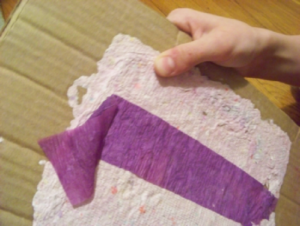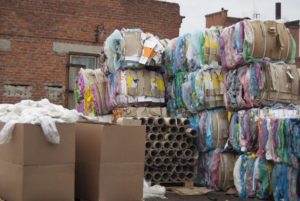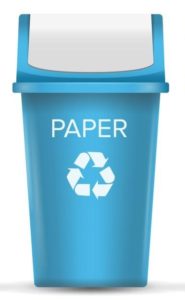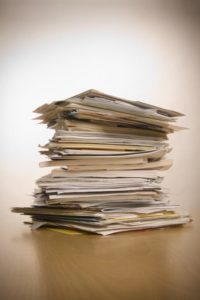Classroom Paper Recycling
This lesson focuses on how engineers and others have developed and improved the manufacturing of recycled paper. Students work in teams to recycle and manufacture their own recycled paper while learning how recycled paper is manufactured on a larger scale in paper facilities. Student teams evaluate current processes for creating paper and develop improvements to the procedure.
- Learn about recycled paper manufacturing.
- Learn about re-engineering.
- Learn how engineering can help solve society’s challenges.
- Learn about teamwork and problem solving.
Age Levels: 8-18
Build Materials (For each team)
Pulp Making Materials
- Blender
- Water
- Sink
- Small pieces of paper products (students can gather and bring in or set up bin at school for classroom scrap)
- Plastic bin
- Paper towels
- Large basin big enough to contain the pulp mixture and to accommodate each team’s paper frame design
- Optional: Cornstarch
Required Materials (Trading/Table of Possibilities)
- Wire mesh (at least two pieces about 10 x 25 cm)
- Wire
- Wood dowels
- Paper clips
- Rolling pin
- Towels
- Wood boards
- Wood blocks
- Pencils
- Fabric pieces
- Thread
- Wax paper
- Aluminum foil
- Plastic wrap
- Dried herbs, leaves, flowers, seeds, spices
Testing Materials
- Pulp
- Large basin big enough to contain the pulp mixture and to accommodate each team’s paper frame design
Materials
- Pulp
- Large basin big enough to contain the pulp mixture and to accommodate each team’s paper frame design
Process
Note: The pulp mixture should be created a few hours prior to the activity. Using a plastic bin containing the pulp, each team should demonstrate how their system makes paper by dipping their system into the vat of pulp to gather a light coating of pulp. Next, students remove the water from their pulp (pressure is important in the beginning, but paper can be either left to dry outside for a day, or can be accelerated with a hair dryer).
After the paper is dry, teams should remove their recycled paper from their systems and share the results with the class.

Design Challenge
You are a team of engineers given the challenge of creating a new system for creating recycled paper. You will review current procedures both for use in the classroom and in manufacturing facilities and design and build an improved system.
You may also incorporate a system for adding color, texture, or designs to your paper — or come up with a design that uses less water, requires less space, or dries faster. You may add other ingredients to the pulp mixture provided to you including dried herbs, leaves, flowers, seeds, thread, or spices that may add color.
Criteria
- Allow paper to dry completely before removing it from the system.
Constraints
- Use only the materials provided.
- Teams may trade unlimited materials.
Several days prior to the activity, ask students to gather paper scraps from home or school. These may include colored papers, paper towels, cardboard, old greeting cards, envelopes, etc. Paper should not have been exposed to food, and should be clean. Suggest that students also gather some colored scraps that they may use separately.
Create a vat of “pulp” for the class to use. This is achieved as follows:
- Have students tear all gathered scrap paper into small pieces then soak overnight in a vat of water (use twice as much scrap paper as you expect to end up in recycled paper).
- A tablespoon of cornstarch will accelerate the dissolving process, but is not required.
- Blend wet paper and water (ratio 2 parts water to 1 part paper) in a blender until it reaches the consistency of gravy. Pour pulp into vat (see materials list) and repeat until vat is half full.
- Break class into teams of 2-4.
- Hand out the Classroom Paper Recycling worksheet, as well as some sheets of paper for sketching designs.
- Discuss the topics in the Background Concepts Section. To introduce the lesson, consider discussing how much paper is used in your school, whether your community participates in recycling programs, and perhaps also consider the interdisciplinary options for this lesson in working with an art teacher or artist in your area.
- Have students view the video available at www.paperrecycles.org/school_recycling which shows one way to make paper in the classroom. The video also shows how recycled paper is manufactured in large quantities in factories. Discuss in class the procedure shown, noting that a screen is a good method for shaping paper and also removing liquids.
- Review the Engineering Design Process, Design Challenge, Criteria, Constraints and Materials.
- Provide each team with their materials.
- Explain that students must develop an improved system for turning pulp into paper in the classroom. They should consider that the pulp will need to have all moisture removed and be allowed to dry. But, the shape, color, patterns of their paper may be whatever they design. For example, some students may want to make paper cups, or have a plaid pattern embedded into their resulting product.
- Announce the amount of time they have to design and build (1 hour recommended).
- Use a timer or an on-line stopwatch (count down feature) to ensure you keep on time. (www.online-stopwatch.com/full-screen-stopwatch). Give students regular “time checks” so they stay on task. If they are struggling, ask questions that will lead them to a solution quicker.
- Students meet and develop a plan for their paper making system. They agree on materials they will need, write/draw their plan, and present their plan to the class. Teams may trade unlimited materials with other teams to develop their ideal parts list.
- Teams build their designs.
- Note: The pulp mixture should be created a few hours prior to the activity. Using a plastic bin containing the pulp, each team should demonstrate how their system makes paper by dipping their system into the vat of pulp to gather a light coating of pulp. Next, students remove the water from their pulp (pressure is important in the beginning, but paper can be either left to dry outside for a day, or can be accelerated with a hair dryer).
After the paper is dry, teams should remove their recycled paper from their systems and share the results with the class.
- As a class, discuss the student reflection questions.
- For more content on the topic, see the “Digging Deeper” section.
Student Reflection (engineering notebook)
- How similar was your paper recycling system to your written design?
- If you found you needed to make changes during the construction phase, describe why your team decided to make revisions.
- Did you add materials to the pulp mixture? If so, did they have the effect in the paper that you intended? How?
- Do you think this exercise will encourage you to recycle materials? Why?
- What other materials do you think could be recycled?
- Do you think that recycling methods have changed over the past twenty years? What technological innovations might have impacted how efficient recycling is today?
- What impact do you think that engineering has had on recycling around the world?
Time Modification
The lesson can be done in as little as 1 class period for older students. However, to help students from feeling rushed and to ensure student success (especially for younger students), split the lesson into two periods giving students more time to brainstorm, test ideas and finalize their design. Conduct the testing and debrief in the next class period.
History of Paper
Paper Science and Engineering
Paper engineers combine training in chemical and physical sciences and chemical engineering as applied to pulp and paper processing. They apply mathematics, chemistry, and engineering to the pulp and paper industry, and often focus on recycling efforts.
History
The history of paper began in ancient Egypt between 3,700 BC – 3,200 BC. They used papyrus for written records, which was a huge improvement over writing on clay tablets. The word “paper” is derived from “papyros,” Ancient Greek for the Cyperus papyrus. The Chinese independently developed a papermaking process during the Han Dynasty, between 202 BC and 220 AD, which is where modern paper originated. The illustration to the right shows some of the Chinese papermaking process. The paper used today is primarily made from wood pulp, a process that has been popular for over 200 years.
Paper Recycling

Paper recycling is the process of recovering waste paper and remaking it into new paper products. There are three main sources of paper that can be used to make recycled paper. These include: Mill broke (which includes left over paper and trimming from the manufacture of paper), Pre-consumer waste (paper products that were thrown own before they were used by people), and Post-consumer waste (used paper materials such as magazines, newspapers, office trash, old phone books or directories). It is important to recycle these materials as they can be used again and again!
The first step in paper recycling is gathering the waste paper. Next, the paper is shredded and soaked in water or special fluids to break down the paper into fibers. Chemicals are sometimes added to remove ink particles from recycled magazines, newspapers and other printed materials. Next, the pulp is cleaned, often using several methods including heat, chemical, and motion. The pulp is pressed and fluids removed, and the resulting new paper product is dried for reuse. Through recycling, new paper is created from paper that would otherwise have been wasted or dumped in a landfill.
In the mid 1900’s paper was almost completely made from new wood pulp. It takes about 3 tons of trees to make one ton of paper if new wood pulp is used. The process also uses a great deal of water. In 2009, the amount of paper recovered for recycling averaged 325 pounds for each man, woman, and child in the United States. However, the United States recycles just about a third of its waste today, which is doubled from what it was a decade ago. In Europe, Austria heads the European Union in its recycling efforts with approximately 60% of its waste being recycled.
- Constraints: Limitations with material, time, size of team, etc.
- Criteria: Conditions that the design must satisfy like its overall size, etc.
- Engineers: Inventors and problem-solvers of the world. Twenty-five major specialties are recognized in engineering (see infographic).
- Engineering Design Process: Process engineers use to solve problems.
- Engineering Habits of Mind (EHM): Six unique ways that engineers think.
- Iteration: Test & redesign is one iteration. Repeat (multiple iterations).
- Mill Broke Paper: Left over paper and trimming from the manufacture of paper.
- Paper Recycling: Process of recovering waste paper and remaking it into new paper products.
- Post-Consumer Paper: Materials such as magazines, newspapers, office trash, old phone books or directories.
- Pre-Consumer Paper: Products thrown out before they were used by people.
- Prototype: A working model of the solution to be tested.
- Recycling: Process of taking materials ready to be thrown away and converting (changing) them into reusable materials.
Internet Connections
Recommended Reading
- Papermaking: The History and Technique of an Ancient Craft (ISBN: 978- 0486236193)
- The Art of Paper-Making: A Practical Handbook (ISBN: 978-0282735081)
Writing Activity
Write an essay or a paragraph about the impact recycling of paper, metals, or other materials has had on the environment. The essay may take a global or a local perspective.
Alignment to Curriculum Frameworks
Note: All lesson plans in this series are aligned to the National Science Education Standards which were produced by the National Research Council and endorsed by the National Science Teacher Association, and if applicable, also to the International Technology Education Association’s Standards for Technological Literacy or the National Council of Teachers of Mathematics’ Principles and Standards for School Mathematics.
National Science Education Standards Grades K-4 (ages 4-9)
CONTENT STANDARD A: Science as Inquiry
As a result of activities, all students should develop
- Abilities necessary to do scientific inquiry
- Understanding about scientific inquiry
CONTENT STANDARD B: Physical Science
As a result of the activities, all students should develop an understanding of
- Properties of objects and materials
CONTENT STANDARD E: Science and Technology
As a result of activities, all students should develop
- Abilities of technological design
CONTENT STANDARD F: Science in Personal and Social Perspectives
As a result of activities, all students should develop understanding of
- Types of resources
- Science and technology in local challenges
CONTENT STANDARD G: History and Nature of Science
As a result of activities, all students should develop understanding of
- Science as a human endeavor
National Science Education Standards Grades 5-8 (ages 10-14)
CONTENT STANDARD A: Science as Inquiry
As a result of activities, all students should develop
- Abilities necessary to do scientific inquiry
CONTENT STANDARD B: Physical Science
As a result of their activities, all students should develop an understanding of
- Properties and changes of properties in matter
CONTENT STANDARD E: Science and Technology
As a result of activities in grades 5-8, all students should develop
- Abilities of technological design
- Understandings about science and technology
CONTENT STANDARD F: Science in Personal and Social Perspectives
As a result of activities, all students should develop understanding of
- Populations, resources, and environments
- Science and technology in society
CONTENT STANDARD G: History and Nature of Science
As a result of activities, all students should develop understanding of
- Science as a human endeavor
- Nature of science
- History of science
National Science Education Standards Grades 9-12 (ages 14-18)
CONTENT STANDARD A: Science as Inquiry
As a result of activities, all students should develop
- Abilities necessary to do scientific inquiry
- Understandings about scientific inquiry
CONTENT STANDARD B: Physical Science
As a result of their activities, all students should develop understanding of
- Structure and properties of matter
CONTENT STANDARD E: Science and Technology
As a result of activities, all students should develop
- Abilities of technological design
- Understandings about science and technology
CONTENT STANDARD F: Science in Personal and Social Perspectives
As a result of activities, all students should develop understanding of
- Natural resources
- Environmental quality
- Natural and human-induced hazards
- Science and technology in local, national, and global challenges
Standards for Technological Literacy – All Ages
Technology and Society
- Standard 4: Students will develop an understanding of the cultural, social, economic, and political effects of technology.
- Standard 5: Students will develop an understanding of the effects of technology on the environment.
- Standard 6: Students will develop an understanding of the role of society in the development and use of technology.
- Standard 7: Students will develop an understanding of the influence of technology on history.
Design
- Standard 8: Students will develop an understanding of the attributes of design.
- Standard 9: Students will develop an understanding of engineering design.
- Standard 10: Students will develop an understanding of the role of troubleshooting, research and development, invention and innovation, and experimentation in problem solving.
Abilities for a Technological World
- Standard 11: Students will develop abilities to apply the design process.
- Standard 13: Students will develop abilities to assess the impact of products and systems.
The Designed World
- Standard 19: Students will develop an understanding of and be able to select and use manufacturing technologies.
 Engineering Teamwork and Planning
Engineering Teamwork and Planning
You are a team of engineers given the challenge of creating a new system for creating recycled paper. When engineers take a fresh look at a product or system and develop improvements, the process is called “re-engineering.” Bear in mind that a screen is a very efficient method for both shaping the paper and removing moisture. You review current procedures both for use in classroom and in manufacturing facilities and re-engineer your improved system. You may also incorporate a system for adding color, texture, or designs to your paper — or come up with a design that uses less water, requires less space, or dries faster. You may add other ingredients to the pulp mixture provided to you including dried herbs, leaves, flowers, seeds, thread, or spices that may add color.
Planning and Design Phase
In the box below (or a separate piece of paper) draw a diagram of your planned recycled paper system, and include a list of materials you plan to use both in the system and in additions to the pulp below.
|
|
| Materials Required for Building:
|
| Materials to be added to pulp, if any:
|
Classroom Review
Present your plan to your class, gather feedback, answer questions, and determine if you wish to make changes to your original plan.

Construction Phase
- Build your frame or system for making paper.
- Test the frame by making recycled paper with the pulp provided by your teacher.
- Be sure to dry your paper thoroughly before removing from whatever frame you create.
Reflection
- How similar was your paper recycling system to your written design?
- If you found you needed to make changes during the construction phase, describe why your team decided to make revisions.
- Did you add materials to the pulp mixture? If so, did they have the effect in the paper that you intended? How?
- Do you think this exercise will encourage you to recycle materials? Why?
- What other materials do you think could be recycled?
- Do you think that recycling methods have changed over the past twenty years? What technological innovations might have impacted how efficient recycling is today?
- What impact do you think that engineering has had on recycling around the world?





 Industrial Engineering
Industrial Engineering
 Computer Engineering
Computer Engineering













